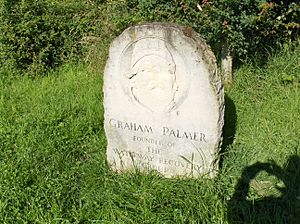Waterway Recovery Group facts for kids
The Waterway Recovery Group (WRG) is a special group that helps fix up old canals and rivers in the United Kingdom. They started in 1970. WRG helps organize people who want to volunteer their time to work on these waterways. It's like a big team that brings together volunteers from all over the country.
Contents
How the Waterway Recovery Group Started
The idea for the Waterway Recovery Group grew over several years. It all began in 1962 when a man named Mr. T. Dodwell helped organize volunteers. They cleared part of the Basingstoke Canal for a boat event. This experience showed how much volunteers could achieve.
After this success, Mr. Dodwell suggested a new idea. He thought the London branch of the Inland Waterways Association (IWA) should create a special team. This team would travel around the country. They would help local groups fix up canals and rivers. Everyone liked the idea!
Soon, working parties were set up. Volunteers helped on the Kennet and Avon Canal, the Stourbridge Canal, and the River Wey. This happened in just a few months.
A little over a year later, a newsletter called Navvies Notebook was created. Mr. G. Palmer, who was a secretary at the IWA, came up with the idea. This newsletter listed places where restoration work was happening. This way, volunteers knew where they could go to help.
The first Navvies Notebook announced work on the River Stour, River Wey, and Kennet and Avon Canal. It also reported on progress at the 16 locks on the Stourbridge Canal. This newsletter helped connect many people who organized volunteer work. By 1967, they were printing 350 copies of each issue!
Some volunteer events were very successful. For example, 45 people worked on the Stourbridge Canal for a whole weekend. Another time, 97 volunteers helped clear a section of the Kennet and Avon Canal in Reading.
Big Volunteer Events
A major step happened in 1968 with "Operation Spring Clean." This project aimed to fix the Ashton Canal, which was in bad shape. Mr. Palmer used Navvies Notebook to gather support for "Operation Ashton." The goal was to show that a large, organized group of volunteers could do a lot of work. They wanted to prove they could achieve more than a small team of paid workers.
On September 21 and 22, 1968, over 600 volunteers showed up! They proved that big volunteer events were very valuable. This event also got a lot of attention from the public. The IWA realized that this publicity was almost as important as the work itself.
Work continued to grow in 1969. The number of volunteer groups, now called "Digs," increased. There were 11 groups in 1967, 16 in 1968, and 23 in 1969. Two big events, one at Marple on the Peak Forest Canal and another at Welshpool on the Montgomery Canal, each had over 200 volunteers.
It was clear that these large numbers of volunteers needed more formal organization. So, in 1970, the Waterways Recovery Group was officially formed. Navvies Notebook continued until 1971, when it was renamed Navvies.
More Successes
The new group kept growing. In October 1971, Navvies announced a volunteer event on the Grantham Canal. This was the first of many projects there. Two months later, important groups like the British Waterways Board and the IWA agreed to restore parts of the Peak Forest Canal and the Ashton Canal.
Mr. Palmer organized a huge event called "Ashtac" on March 25–26, 1972. Over 1000 volunteers from all over Britain came! They removed tons of rubbish from the canals. The British Waterways Board was very impressed. They even published a document about how much volunteers had helped since 1968.
Another big event, "The Droitwich Dig," happened on October 27–28, 1973. WRG worked with the Droitwich Canals Trust. They used their experience to make sure the 500 volunteers who attended were put to good use.
What the Waterway Recovery Group Does
WRG organizes special "canal camps" every year. These are usually week-long trips. Volunteers of all ages and abilities can join. These camps are like "working holidays" where people help restore canals and other waterways. Many camps happen in the summer, and WRG even has a Christmas camp!
WRG also helps set up and take down the Inland Waterways Association's National Festival. This festival is a main way for the IWA to raise money. It's also a chance for boaters and the public to see the work that IWA and WRG do. In 2012, WRG and IWA volunteers helped with the waterways for the London 2012 Olympic Games.
WRG owns a fleet of vans and a lot of equipment. This includes excavators, dumpers, pumps, mixers, and winches. They use these tools to help with their restoration projects.
Local Groups and Newsletters
WRG has regional groups across England. These groups organize weekend trips to restoration projects. Some of the current local groups are London, Essex, North West, South West, and Bit In The Middle (which covers the south midlands). WRG also publishes a newsletter called "Navvies" six times a year.
Even though WRG started as its own group, it is now part of the Inland Waterways Association. The IWA helps cover WRG's main costs. However, WRG still needs fundraising and donations to pay for its restoration work.
Since 1996, the chairman of WRG has been Mike Palmer.



